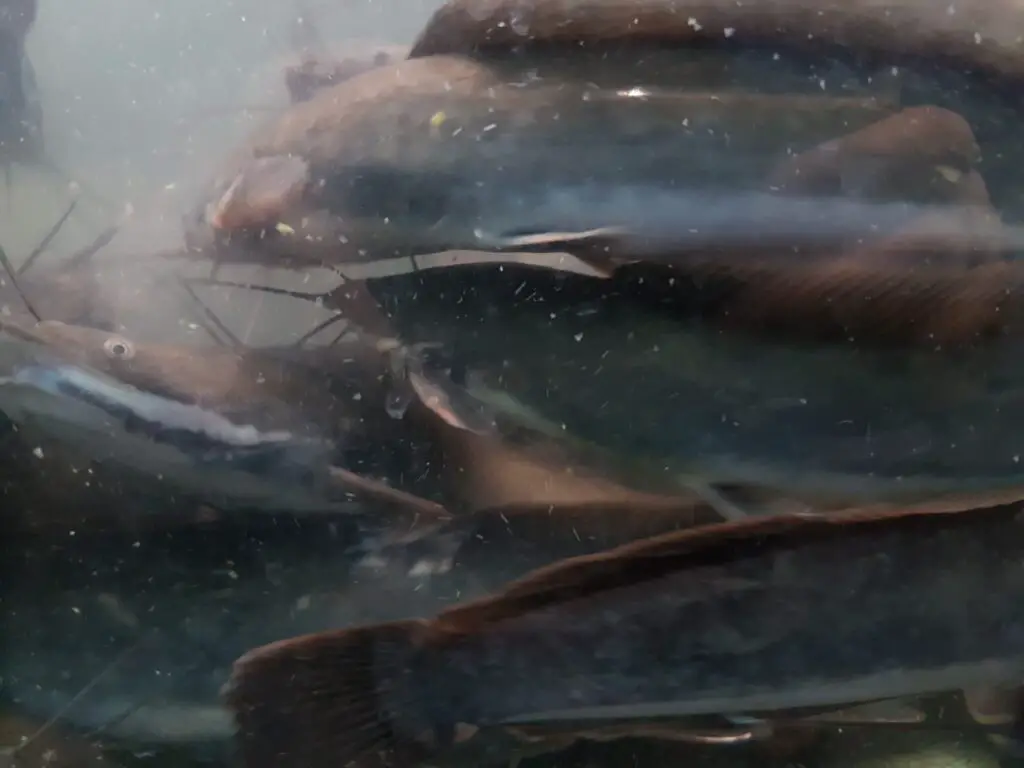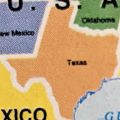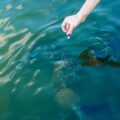The US is home to a total of 30 species of catfish spread over various water bodies. The three catfish most commonly found here, also called The Big Three by anglers, are blue catfish, channel catfish, and flathead catfish. Other than that, there are also decent numbers of yellow, black, and brown bullheads. The population of white catfish is small, whereas the headwater catfish is quite rare.

Channel Catfish
Channel catfish are distributed all across the United States. Their native range is the Great Lakes and St. Lawrence River, the Mississippi River, the Missouri River System, the Gulf of Mexico, Nebraska, and other parts of Mexico. They have also been introduced to the Atlantic Coast north of Florida.
Channel catfish can be found near woody drift piles, wing dikes, shorelines, sand bars, and other protected and covered areas.
Platte River, Nebraska
Research by A.J. Blank, Marty Hamel, Jonathan J. Spurgeon, and Mark Pegg assessed an estimated range for the abundance of channel catfish in the Platte River of Nebraska. Within a 10km sampling reach, the estimate ranged from 8,281 to 24,261 channel catfish.
From this range, we can average and get (24262–8281)/2 = 7,990, or approximately 8,000 mean estimates of channel catfish per 10 km. The total length of the Platte is 500 km. Assuming the distribution to be uniform, the entire river may contain a total of (8,000/10) x 500 = 400,000 channel catfish.
Missouri River Basin
The Missouri River begins in southwestern Montana with the Gallatin, Jefferson, and Madison Rivers, and then it empties into the Mississippi River in St. Louis, Missouri. The Missouri River basin covers 500,000 square miles or 804,000 square kilometers and a volume of 48240 cubic kilometers.
A total of 25 species of fish can be found in abundance in this river basin. One of the most abundant of them is the channel cat. Let us assume that channel cats comprise 0.05% of the total volume of the basin.
The volume occupied by the channel cats is (48240×0.005) = 241.2 cubic kilometers. This is equivalent to 6.37183e+13 gallons. Channel cats grow up to an average of 30 inches. Assuming there is one channel cat in every 100 gallons, and they are equally distributed (for the sake of easy calculation), then the number of channel cats in the river basin is 6.371831 + 11.
Kansas River Basin
At 53,000 miles or 85,000 kilometers area and approximately 2380 cubic kilometers, the Kansas River basin contains as many as 116 native species of fish, which is more than any other river basin in the USA.
Let us assume that
occupy 0.2% of the total volume of the river. Which means they cover (2380×0.002) = 4.76 cubic kilometers. This is equivalent to 1.2575e+12 gallons. Again, assuming one channel catfish in every 100 gallons, the total number of channel catfish in the basin is 1.2575 e + 10.
An approximate number of channel catfish:
The total number of channel cats in the USA is (1.2575e+10 + 6.37183e+11 + 400,000) = 6.497e+11.
Considering the intersection areas among the river basins, we can deduct e+10 numbers of catfish to reach a more accurate value. Thus, the final number is 6.397e+11.
Blue catfish
Blue catfish are highly abundant in the lower Kansas river. They are native to the Mississippi, Missouri, Ohio, and Rio Grande River basins. They can be found in both large rivers and reservoirs.
Kansas River Basin
Let’s assume that blue catfish occupy 0.1% of the total volume of the Kansas river basin. This means they occupy a space equal to (2380×0.001) = 2.38 cubic kilometers. This is equivalent to 6.287e+11 gallons.
Blue catfish grow an average of 25 inches in length. Considering that each blue cat needs 150 gallons of space in the river and they are all equally distributed within the 238 cubic kilometers, the total number of blue cats within the river is 4.1913e+9.
Missouri River Basin
Blue catfish can be found in more rocky areas of the Missouri River, where the water has a faster flow. Let’s assume that 0.05% of the basin is occupied by this species, which makes the volume covered by them (48240×0.0005) = 24.12 cubic kilometers. This is equivalent to 6.37183e+12 gallons.
Again, assuming one blue cat for every 150 gallons of water, the total number of channel cats in the river basin is 4.248 e + 11.
Rio Grande Basin
Rio Grande Basin or watershed has an area of 182,200 square miles or 472,000 square kilometers within the USA, the rest being in Mexico. With an average depth of 18 meters, the volume of the basin is approximately 8496 cubic kilometers.
Let’s assume that blue cats occupy 0.01% of the volume of the basin. So, the volume occupied by them is (8496×0.0001) = 0.8496 cubic kilometers. This is equivalent to 2.244406e+11 gallons.
So, the number of blue catfish within this volume is (2.244406e+11 / 150) = 1.4962e+9.
The approximate number of blue catfish
The total number of blue catfish in the river systems of the USA is (1.4962e+10 + 4.248e+11 + 4.1913e+9) = 4.816e+11.
Considering the area of intersection among these basins, we can deduct e+10 from the total number to reach a more accurate value, which is 3.816e+11.
Flathead Catfish
Flathead catfish, just like Channel catfish, are an abundant species in Nebraska. Native to the lower Great Lakes and the Mississippi River basin, their distribution spreads from western Pennsylvania to the southward direction. In Pennsylvania, flatheads are seen in the Ohio, Allegheny, and Monongahela rivers.
Great Lakes
The five Great Lakes combinedly cover a minimum volume of 22,671 cubic kilometers. Assuming flathead catfish occupy 0.01% of this volume, their area of coverage is (22,671 x 0.0001) = 2.27 cubic kilometers. This is equivalent to 5.99671e+11 gallons.
The flathead catfish can grow up to an average of 50 inches. Let’s assume that each flathead cat occupies 500 gallons of volume. So within the assumed area, the number of flat catfish is (5.99671e+11 / 500) = 1.1993e+10.
Mississippi river basin
Stretching for 1,245,000 miles or approximately 2,004,000 square kilometers, the Mississippi river basin has an average depth of 200 feet or 0.061km. The approximate volume of the river basin is 122244 cubic kilometers.
Assuming that 0.05% of the basin (122244 x 0.0005) = 61.122 cubic kilometers is occupied by flatheads, the gallon equivalent is 1.614672e+13. The number of flatheads in the basin is (1.614672e+13 / 500) = 3.23e+10.
Allegheny River
This river has an approximate volume of 73.72 cubic kilometers. Let’s assume 0.05% or (73.72 x 0.0005) = 0.037 cubic kilometers occupied by flatheads. In gallons, this is 9.77437e+9. So the number of flatheads in the river is (9.77437e+9 / 500) = 1.954e+6.
Monongahela River
The average volume of the river is 1.28 cubic kilometers. Assuming 0.001% of it is flatheads, the volume is (1.28 x 0.00001) = 1.28e-5 or 3381402.27 gallons. So the number of flatheads in this river is (3381402.27 / 500) = 6762.
The approximate number of flathead catfish
The total number stands (6762 + 1.954e+6 + 3.23e+10 + 1.1993e+11) = 7.22e+10. Considering the area of intersection among these basins, we can deduct e+10 from the total number to reach a more accurate value, which is 6.22e+11.
White Catfish
White catfish are native to the Atlantic Coast watersheds from the lower Hudson River in New York south to Florida and Mississippi. Their range stretches up to the Susquehanna and Delaware River systems.
Hudson river’s average volume is 620 cubic meters. Assuming 5% of this volume is occupied by white catfish, we get a coverage space of (620 x 0.05) = 31 cubic meters or 8189.33 gallons. Since white catfish have an average length of 12 inches, we can assume there is one every 30 gallons. The number is (8189 / 30) = 273.
Susquehanna has an approximate volume of 1160 cubic meters. Assuming 5% or (1160 x 0.05) = 58 cubic meters occupied by them; they cover 15322 gallons. The number of white cats there is approximately 511.
The Delaware River System has a volume of about 1243.38 cubic kilometers. Assuming 1% (1243.38 x 0.01) = 12.44 cubic kilometers or 3.2863e+12 is occupied by white cats, their number is 1.095e+11.
The total number (1.095e+11 + 511 + 273) = 1.095e+11.
Yellow bullhead
Yellow bullhead is also a part of the catfish family. Their range spreads across the Central and Eastern US. Their population extends up to the Great Lakes in Canada.
Yellow bullheads grow up to an average of 9 inches, so let’s assume that there is one bullhead every 20 gallons.
St. Lawrence Great Lakes consists of Lake Huron, Lake Erie, and Lake Ontario, creating a volume of 10,500 cubic kilometers. Assuming 0.005% of it is yellow bulls, the covered space is 0.525 cubic kilometers or 1.4e+10 gallons. The number of fish there is 7e+7.
The Mississippi river basin has (122244 x 0.000005) = 0.61122 cubic kilometers or 1.614672e+11 gallons occupied by yellow bulls. The number is 8.07e+9.
The total number stands (8.07e+9 + 7e+7) = 8.14e+9.
Brown Bullhead
Brown bullheads are native to the northeastern US and Canada. They are spread across the Hudson Bay, the Great Lakes, Mississippi Basin, and the St. Lawrence River. They can be found all over the United States, from California and Idaho to Louisiana and Hawaii.
Brown bulls grow up to an average of 10 inches, so let’s assume each occupies 20 gallons of space.
Let’s assume they occupy 0.001% of the Great Lakes, 0.0001% of the Mississippi Basin (since they’re endangered there), and 0.001% of the St. Lawrence River. Considering the volumes of these, the gallons equivalent stands-
(22,671 x 0.00001) = 0.227 cubic kilometers or 5.99671e+8 gallons, (122244 x 0.000001) = 0.0122 km³ or 3.222899e+7 gallons, and (102159 x 0.00001) = 1.02 km³ or 2.6946e+9 gallons respectively. Dividing each by 20, we get a total of (2.998e+7 + 1.347e+8 + 1.611e+6) = 1.663e+8.
Black Bullhead
Black Bullheads are abundantly found in the Great Lakes, Hudson Bay, and Mississippi Rivers basins.
Black bullheads grow up to an average of 12 inches, so we assume that each needs 30 gallons of space in the water.
For the Hudson River, assuming the population density is 1%, (620 x 0.01) = 6.2 cubic meters or 1637.87 gallons, which means (1637.87 / 30) = 55. (approximately) fishes are there. If it’s 0.0001% for the Great Lakes, we get (22,671 x 0.000001) = 0.0227 cubic kilometers or 5.99671e+7 gallons, which gives 1.9986e+8 fish.
If it’s 0.0001% for Mississippi Basin as well, then it’s (122244 x 0.000001) = 0.0122 km³ or 3.222899e+7 gallons, which gives 1.074e+8 fish.
The total number is = (1.074e+8 + 1.9986e+8 + 55) = 2.0093e+8.
Ultimate total number of catfish
Combinedly, the total number of catfish in the USA is-
(2.0093e+8 + 1.663e+8 + 8.14e+9 + 1.095e+11 + 6.22e+11 + 3.816e+11 + 6.397e+11) = 1.761e+12.
Considering the smaller lakes, ponds, tributaries, reservoirs, and other water bodies that were taken out of consideration, we can add 1e+10 to the amount to reach a more accurate value, which is 1.77e+12.
The number of catfish in the USA is 1.77e+12 or 1,770,000,000,000, is our best approximation based on the numbers we came to above.











